2010 Peugeot 3008 Dag light
[x] Cancel search: lightPage 139 of 315
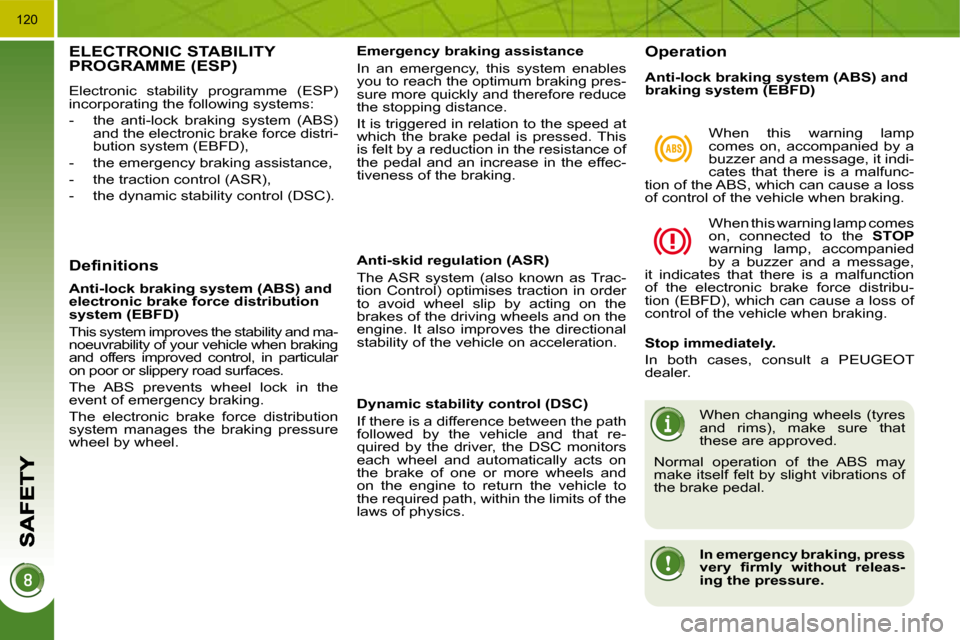
120
ELECTRONIC STABILITY PROGRAMME (ESP)
Electronic stability programme (ESP)
incorporating the following systems:
- the anti-lock braking system (ABS) and the electronic brake force distri-
bution system (EBFD),
- the emergency braking assistance,
- the traction control (ASR),
- the dynamic stability control (DSC).
Definitions Anti-skid regulation (ASR)
The ASR system (also known as Trac-
tion Control) optimises traction in order
to avoid wheel slip by acting on the
brakes of the driving wheels and on the
engine. It also improves the directional
stability of the vehicle on acceleration.
Dynamic stability control (DSC)
If there is a difference between the path
followed by the vehicle and that re-
quired by the driver, the DSC monitors
each wheel and automatically acts on
the brake of one or more wheels and
on the engine to return the vehicle to
the required path, within the limits of the
laws of physics.
Emergency braking assistance
In an emergency, this system enables
you to reach the optimum braking pres-
sure more quickly and therefore reduce
the stopping distance.
It is triggered in relation to the speed at
which the brake pedal is pressed. This
is felt by a reduction in the resistance of
the pedal and an increase in the effec-
tiveness of the braking.
Anti-lock braking system (ABS) and
electronic brake force distribution
system (EBFD)
This system improves the stability and ma-
noeuvrability of your vehicle when braking
and offers improved control, in particular
on poor or slippery road surfaces.
The ABS prevents wheel lock in the
event of emergency braking.
The electronic brake force distribution
system manages the braking pressure
wheel by wheel.
Operation
When this warning lamp
comes on, accompanied by a
�b�u�z�z�e�r� �a�n�d� �a� �m�e�s�s�a�g�e�,� �i�t� �i�n�d�i�-
cates that there is a malfunc-
tion of the ABS, which can cause a loss
of control of the vehicle when braking.
When this warning lamp comes
on, connected to the STOP
warning lamp, accompanied
�b�y� �a� �b�u�z�z�e�r� �a�n�d� �a� �m�e�s�s�a�g�e�,�
it indicates that there is a malfunction
of the electronic brake force distribu-
tion (EBFD), which can cause a loss of
control of the vehicle when braking.
Stop immediately.
In both cases, consult a PEUGEOT
dealer.
When changing wheels (tyres
and rims), make sure that
these are approved.
Normal operation of the ABS may
make itself felt by slight vibrations of
the brake pedal.
In emergency braking, press
�v�e�r�y� �fi� �r�m�l�y� �w�i�t�h�o�u�t� �r�e�l�e�a�s�-
ing the pressure.
Anti-lock braking system (ABS) and
braking system (EBFD)
Page 140 of 315
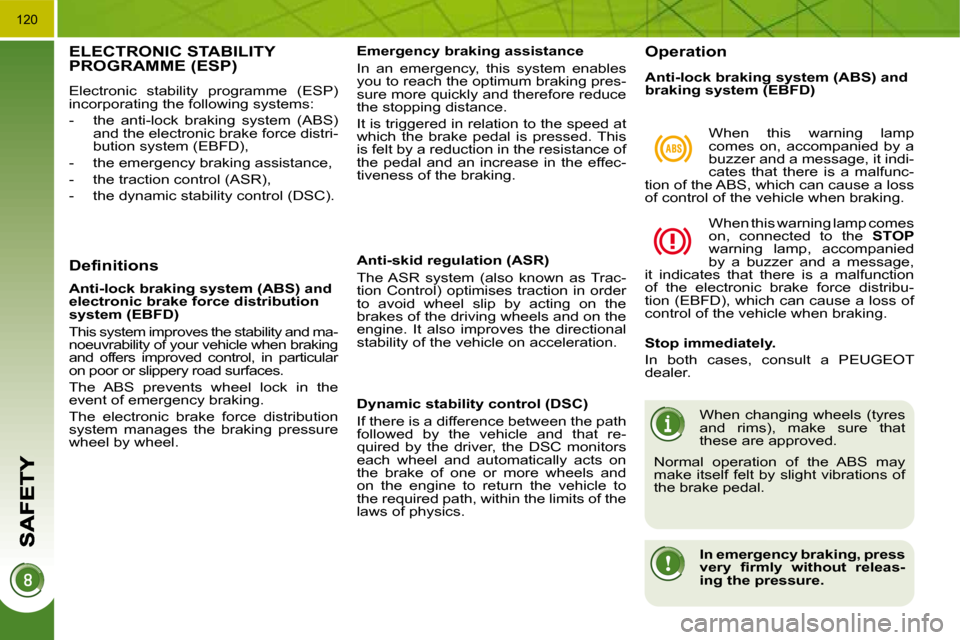
120
ELECTRONIC STABILITY PROGRAMME (ESP)
Electronic stability programme (ESP)
incorporating the following systems:
- the anti-lock braking system (ABS) and the electronic brake force distri-
bution system (EBFD),
- the emergency braking assistance,
- the traction control (ASR),
- the dynamic stability control (DSC).
Definitions Anti-skid regulation (ASR)
The ASR system (also known as Trac-
tion Control) optimises traction in order
to avoid wheel slip by acting on the
brakes of the driving wheels and on the
engine. It also improves the directional
stability of the vehicle on acceleration.
Dynamic stability control (DSC)
If there is a difference between the path
followed by the vehicle and that re-
quired by the driver, the DSC monitors
each wheel and automatically acts on
the brake of one or more wheels and
on the engine to return the vehicle to
the required path, within the limits of the
laws of physics.
Emergency braking assistance
In an emergency, this system enables
you to reach the optimum braking pres-
sure more quickly and therefore reduce
the stopping distance.
It is triggered in relation to the speed at
which the brake pedal is pressed. This
is felt by a reduction in the resistance of
the pedal and an increase in the effec-
tiveness of the braking.
Anti-lock braking system (ABS) and
electronic brake force distribution
system (EBFD)
This system improves the stability and ma-
noeuvrability of your vehicle when braking
and offers improved control, in particular
on poor or slippery road surfaces.
The ABS prevents wheel lock in the
event of emergency braking.
The electronic brake force distribution
system manages the braking pressure
wheel by wheel.
Operation
When this warning lamp
comes on, accompanied by a
�b�u�z�z�e�r� �a�n�d� �a� �m�e�s�s�a�g�e�,� �i�t� �i�n�d�i�-
cates that there is a malfunc-
tion of the ABS, which can cause a loss
of control of the vehicle when braking.
When this warning lamp comes
on, connected to the STOP
warning lamp, accompanied
�b�y� �a� �b�u�z�z�e�r� �a�n�d� �a� �m�e�s�s�a�g�e�,�
it indicates that there is a malfunction
of the electronic brake force distribu-
tion (EBFD), which can cause a loss of
control of the vehicle when braking.
Stop immediately.
In both cases, consult a PEUGEOT
dealer.
When changing wheels (tyres
and rims), make sure that
these are approved.
Normal operation of the ABS may
make itself felt by slight vibrations of
the brake pedal.
In emergency braking, press
�v�e�r�y� �fi� �r�m�l�y� �w�i�t�h�o�u�t� �r�e�l�e�a�s�-
ing the pressure.
Anti-lock braking system (ABS) and
braking system (EBFD)
Page 146 of 315
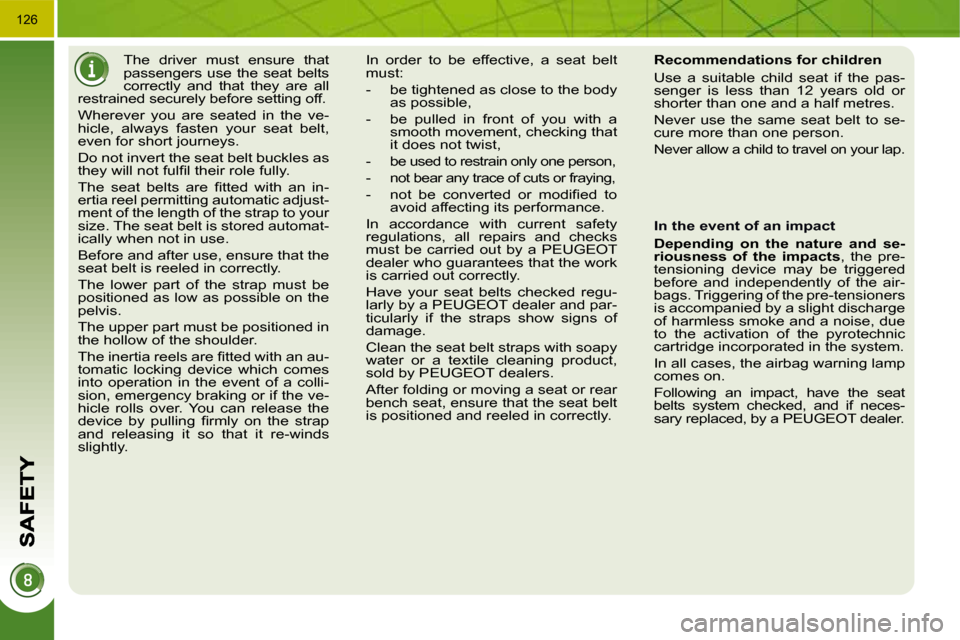
126
The driver must ensure that
passengers use the seat belts
correctly and that they are all
restrained securely before setting off.
Wherever you are seated in the ve-
hicle, always fasten your seat belt,
�e�v�e�n� �f�o�r� �s�h�o�r�t� �j�o�u�r�n�e�y�s�.�
Do not invert the seat belt buckles as
�t�h�e�y� �w�i�l�l� �n�o�t� �f�u�l�fi� �l� �t�h�e�i�r� �r�o�l�e� �f�u�l�l�y�.�
� �T�h�e� �s�e�a�t� �b�e�l�t�s� �a�r�e� �fi� �t�t�e�d� �w�i�t�h� �a�n� �i�n�-
�e�r�t�i�a� �r�e�e�l� �p�e�r�m�i�t�t�i�n�g� �a�u�t�o�m�a�t�i�c� �a�d�j�u�s�t�-
ment of the length of the strap to your
�s�i�z�e�.� �T�h�e� �s�e�a�t� �b�e�l�t� �i�s� �s�t�o�r�e�d� �a�u�t�o�m�a�t�-
ically when not in use.
Before and after use, ensure that the
seat belt is reeled in correctly.
The lower part of the strap must be
positioned as low as possible on the
pelvis.
The upper part must be positioned in
the hollow of the shoulder.
� �T�h�e� �i�n�e�r�t�i�a� �r�e�e�l�s� �a�r�e� �fi� �t�t�e�d� �w�i�t�h� �a�n� �a�u�-
tomatic locking device which comes
into operation in the event of a colli-
sion, emergency braking or if the ve-
hicle rolls over. You can release the
�d�e�v�i�c�e� �b�y� �p�u�l�l�i�n�g� �fi� �r�m�l�y� �o�n� �t�h�e� �s�t�r�a�p�
and releasing it so that it re-winds
slightly. In order to be effective, a seat belt
must:
- be tightened as close to the body
as possible,
- be pulled in front of you with a smooth movement, checking that
it does not twist,
-
be used to restrain only one person,
-
not bear any trace of cuts or fraying,
� � �-� � �n�o�t� �b�e� �c�o�n�v�e�r�t�e�d� �o�r� �m�o�d�i�fi� �e�d� �t�o� avoid affecting its performance.
In accordance with current safety
regulations, all repairs and checks
must be carried out by a PEUGEOT
dealer who guarantees that the work
is carried out correctly.
Have your seat belts checked regu-
larly by a PEUGEOT dealer and par-
ticularly if the straps show signs of
damage.
Clean the seat belt straps with soapy
water or a textile cleaning product,
sold by PEUGEOT dealers.
After folding or moving a seat or rear
bench seat, ensure that the seat belt
is positioned and reeled in correctly. Recommendations for children
Use a suitable child seat if the pas-
senger is less than 12 years old or
shorter than one and a half metres.
Never use the same seat belt to se-
cure more than one person.
Never allow a child to travel on your lap.
In the event of an impact
Depending on the nature and se-
riousness of the impacts , the pre-
tensioning device may be triggered
before and independently of the air-
bags. Triggering of the pre-tensioners
is accompanied by a slight discharge
of harmless smoke and a noise, due
to the activation of the pyrotechnic
cartridge incorporated in the system.
In all cases, the airbag warning lamp
comes on.
Following an impact, have the seat
belts system checked, and if neces-
sary replaced, by a PEUGEOT dealer.
Page 147 of 315
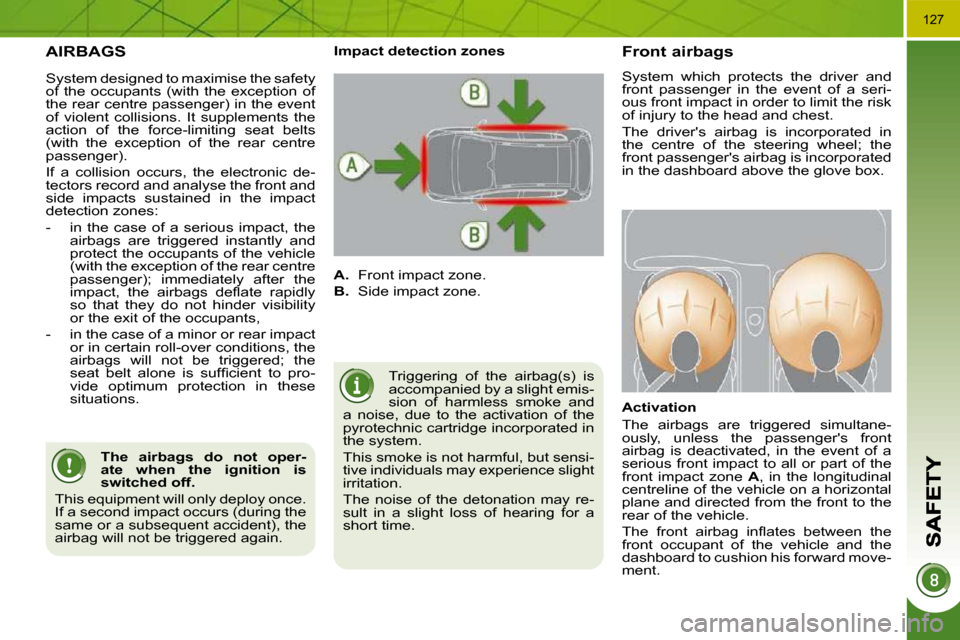
127
AIRBAGS
Triggering of the airbag(s) is
accompanied by a slight emis-
sion of harmless smoke and
a noise, due to the activation of the
pyrotechnic cartridge incorporated in
the system.
This smoke is not harmful, but sensi-
tive individuals may experience slight
irritation.
The noise of the detonation may re-
sult in a slight loss of hearing for a
short time.
Front airbags
System which protects the driver and
front passenger in the event of a seri-
ous front impact in order to limit the risk
�o�f� �i�n�j�u�r�y� �t�o� �t�h�e� �h�e�a�d� �a�n�d� �c�h�e�s�t�.�
The driver's airbag is incorporated in
the centre of the steering wheel; the
front passenger's airbag is incorporated
in the dashboard above the glove box.
Activation
The airbags are triggered simultane-
ously, unless the passenger's front
airbag is deactivated, in the event of a
serious front impact to all or part of the
�f�r�o�n�t� �i�m�p�a�c�t� �z�o�n�e� � A , in the longitudinal
�c�e�n�t�r�e�l�i�n�e� �o�f� �t�h�e� �v�e�h�i�c�l�e� �o�n� �a� �h�o�r�i�z�o�n�t�a�l�
plane and directed from the front to the
rear of the vehicle.
� �T�h�e� �f�r�o�n�t� �a�i�r�b�a�g� �i�n�fl� �a�t�e�s� �b�e�t�w�e�e�n� �t�h�e�
front occupant of the vehicle and the
dashboard to cushion his forward move-
ment.
Impact detection zones
A. � � �F�r�o�n�t� �i�m�p�a�c�t� �z�o�n�e�.�
B. � � �S�i�d�e� �i�m�p�a�c�t� �z�o�n�e�.� �
The airbags do not oper-
ate when the ignition is
switched off.
This equipment will only deploy once.
If a second impact occurs (during the
same or a subsequent accident), the
airbag will not be triggered again.
System designed to maximise the safety
of the occupants (with the exception of
the rear centre passenger) in the event
of violent collisions. It supplements the
action of the force-limiting seat belts
(with the exception of the rear centre
passenger).
If a collision occurs, the electronic de-
tectors record and analyse the front and
side impacts sustained in the impact
�d�e�t�e�c�t�i�o�n� �z�o�n�e�s�:�
- in the case of a serious impact, the
airbags are triggered instantly and
protect the occupants of the vehicle
(with the exception of the rear centre
passenger); immediately after the
�i�m�p�a�c�t�,� �t�h�e� �a�i�r�b�a�g�s� �d�e�fl� �a�t�e� �r�a�p�i�d�l�y�
so that they do not hinder visibility
or the exit of the occupants,
- in the case of a minor or rear impact or in certain roll-over conditions, the
airbags will not be triggered; the
�s�e�a�t� �b�e�l�t� �a�l�o�n�e� �i�s� �s�u�f�fi� �c�i�e�n�t� �t�o� �p�r�o�-
vide optimum protection in these
situations.
Page 153 of 315

132
With the vehicle stationary, to apply the
parking brake whether the engine is
running or off, pull on control A .
The application of the parking brake is
�c�o�n�fi� �r�m�e�d� �b�y�:�
- lighting of the braking warn-ing lamp and of the warning
lamp P on the control A ,
When the driver’s door is opened with
the engine running, a beep is heard and
a message is displayed if the parking
brake has not been applied, unless the
selector lever is in position P (Park) in
the case of an automatic gearbox.
Manual release
With the ignition on or the engine run-
ning, to release the parking brake,
press on the brake
pedal or the accel-
erator, pull then release control A .
The full application of the parking brake
�i�s� �c�o�n�fi� �r�m�e�d� �b�y�:�
- extinction of the braking warning lamp and of the
warning lamp P on control A ,
If you pull control A without
pressing the brake pedal, the
parking brake will not be re-
leased and a warning lamp will
light up on the instrument panel.
Manual application Maximum application
If necessary, you can utilise maximum
application of the parking brake. It is
obtained by means of a long pull on
control A , until you see the message
"Handbrake on" and a beep is heard.
In the case of towing, a loaded
vehicle or parking on a gradi-
ent, make a maximum applica-
tion of the parking brake then turn the
front wheels towards the pavement
and engage a gear when you park.
After a maximum application, the re-
lease time will be longer.
Before leaving the vehicle,
check that parking brake
warning lamp on the instru-
�m�e�n�t� �p�a�n�e�l� �i�s� �o�n�,� �n�o�t� �fl� �a�s�h�i�n�g�.� � �
Maximum application is essential:
- in the case of a vehicle towing a caravan or a trailer, if the automatic
functions are activated but you are
applying the parking brake manually,
- when the gradient you are parked on is variable in its effect (e.g. on a
ferry, in a lorry, during towing),
- display of the message "Handbrake on". - display of the message
"Handbrake off".
Page 154 of 315
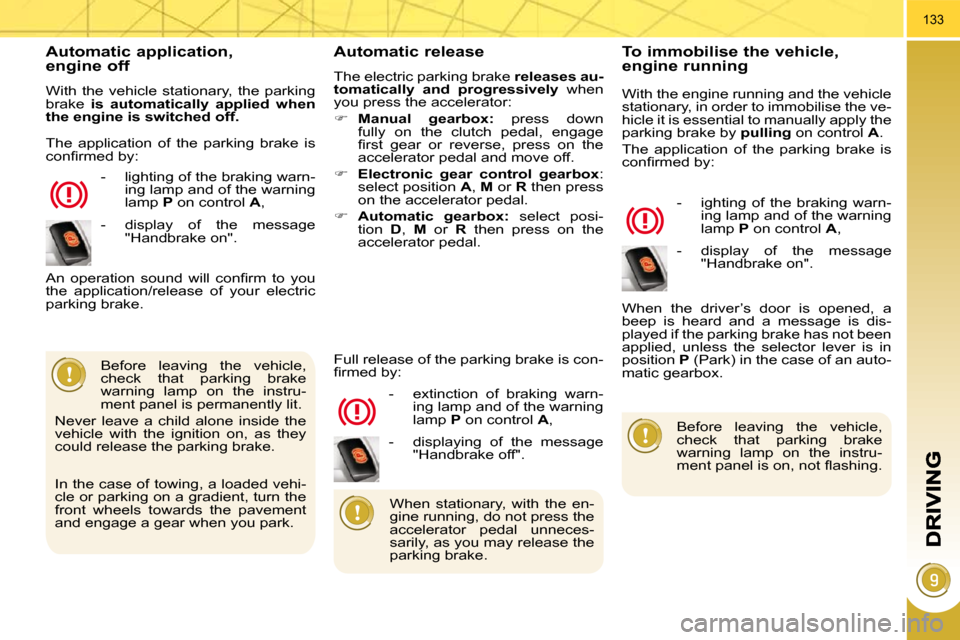
133
Automatic application, engine off
With the vehicle stationary, the parking
brake is automatically applied when
the engine is switched off.
- lighting of the braking warn- ing lamp and of the warning
lamp P on control A ,
Automatic release
The electric parking brake releases au-
tomatically and progressively when
you press the accelerator:
� Manual gearbox: press down
fully on the clutch pedal, engage
�fi� �r�s�t� �g�e�a�r� �o�r� �r�e�v�e�r�s�e�,� �p�r�e�s�s� �o�n� �t�h�e�
accelerator pedal and move off.
� Electronic gear control gearbox :
select position A , M or R then press
on the accelerator pedal.
� Automatic gearbox: select posi-
tion D , M or R then press on the
accelerator pedal.
Before leaving the vehicle,
check that parking brake
warning lamp on the instru-
ment panel is permanently lit.
Never leave a child alone inside the
vehicle with the ignition on, as they
could release the parking brake. - extinction of braking warn-
ing lamp and of the warning
lamp P on control A ,
� �A�n� �o�p�e�r�a�t�i�o�n� �s�o�u�n�d� �w�i�l�l� �c�o�n�fi� �r�m� �t�o� �y�o�u�
the application/release of your electric
parking brake.
Full release of the parking brake is con-
�fi� �r�m�e�d� �b�y�:�
To immobilise the vehicle, engine running
With the engine running and the vehicle
stationary, in order to immobilise the ve-
hicle it is essential to manually apply the
parking brake by pulling on control A .
The application of the parking brake is
�c�o�n�fi� �r�m�e�d� �b�y�:�
- ighting of the braking warn-ing lamp and of the warning
lamp P on control A ,
When the driver’s door is opened, a
beep is heard and a message is dis-
played if the parking brake has not been
applied, unless the selector lever is in
position P (Park) in the case of an auto-
matic gearbox.
Before leaving the vehicle,
check that parking brake
warning lamp on the instru-
�m�e�n�t� �p�a�n�e�l� �i�s� �o�n�,� �n�o�t� �fl� �a�s�h�i�n�g�.� � �
When stationary, with the en-
gine running, do not press the
accelerator pedal unneces-
sarily, as you may release the
parking brake.
The application of the parking brake is
�c�o�n�fi� �r�m�e�d� �b�y�:�
- display of the message "Handbrake on".
In the case of towing, a loaded vehi-
cle or parking on a gradient, turn the
front wheels towards the pavement
and engage a gear when you park. - displaying of the message
"Handbrake off". - display of the message
"Handbrake on".
Page 155 of 315

134
Particular situations Emergency braking
In the event of a failure of the main ser-
vice brake or in an exceptional situation
(e.g. driver taken ill, under instruction,
etc) a continuous pull on control A will
stop the vehicle.
The electronic stability programme
(ESP) provides stability during emer-
gency braking.
If the emergency braking malfunctions,
one of the following messages will be
displayed:
- "Parking brake faulty".
- "Parking brake control faulty".
In certain situations (e.g.
starting the engine), the parking brake
can automatically alter its force. This
is normal operation.
To advance your vehicle a few cen-
timetres without starting the engine,
but with the ignition on, press on the
brake pedal and release the parking
brake by pulling then releasing con-
trol A . The full release of the parking
�b�r�a�k�e� �i�s� �c�o�n�fi� �r�m�e�d� �b�y� �t�h�e� �e�x�t�i�n�c�t�i�o�n�
of warning lamp on control A and of
the warning lamp on the instrument
panel and the displaying of the mes-
sage "Handbrake off".
If the parking brake malfunctions
while applied or if the battery runs
�fl� �a�t�,� �a�n� �e�m�e�r�g�e�n�c�y� �r�e�l�e�a�s�e� �i�s� �a�l�w�a�y�s�
possible.
If a failure of the ESP sys-
tem is signalled by the light-
ing of this warning lamp, then
braking stability is not guaranteed.
The emergency braking must
only be used in exceptional
circumstances.
In this event, stability must be assured
by the driver by repeating alternate "pull
release" actions on control
A .
Page 160 of 315
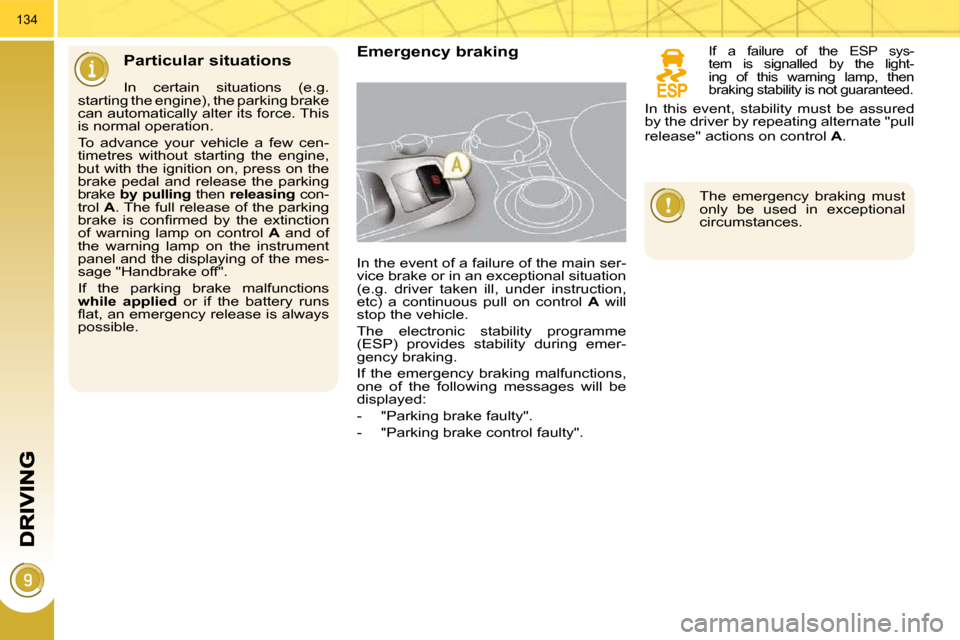
134
Particular situations Emergency braking
In the event of a failure of the main ser-
vice brake or in an exceptional situation
(e.g. driver taken ill, under instruction,
etc) a continuous pull on control A will
stop the vehicle.
The electronic stability programme
(ESP) provides stability during emer-
gency braking.
If the emergency braking malfunctions,
one of the following messages will be
displayed:
- "Parking brake faulty".
- "Parking brake control faulty".
In certain situations (e.g.
starting the engine), the parking brake
can automatically alter its force. This
is normal operation.
To advance your vehicle a few cen-
timetres without starting the engine,
but with the ignition on, press on the
brake pedal and release the parking
brake by pulling then releasing con-
trol A . The full release of the parking
�b�r�a�k�e� �i�s� �c�o�n�fi� �r�m�e�d� �b�y� �t�h�e� �e�x�t�i�n�c�t�i�o�n�
of warning lamp on control A and of
the warning lamp on the instrument
panel and the displaying of the mes-
sage "Handbrake off".
If the parking brake malfunctions
while applied or if the battery runs
�fl� �a�t�,� �a�n� �e�m�e�r�g�e�n�c�y� �r�e�l�e�a�s�e� �i�s� �a�l�w�a�y�s�
possible.
If a failure of the ESP sys-
tem is signalled by the light-
ing of this warning lamp, then
braking stability is not guaranteed.
The emergency braking must
only be used in exceptional
circumstances.
In this event, stability must be assured
by the driver by repeating alternate "pull
release" actions on control
A .